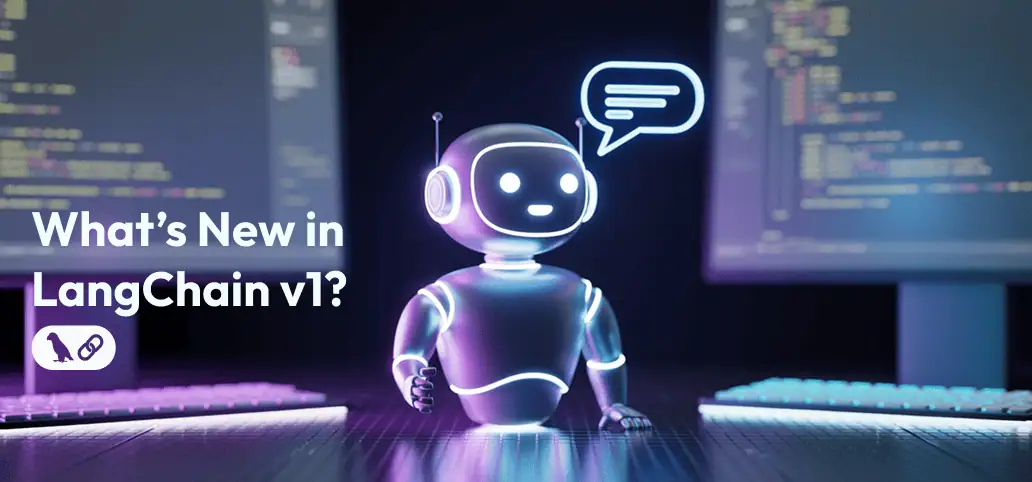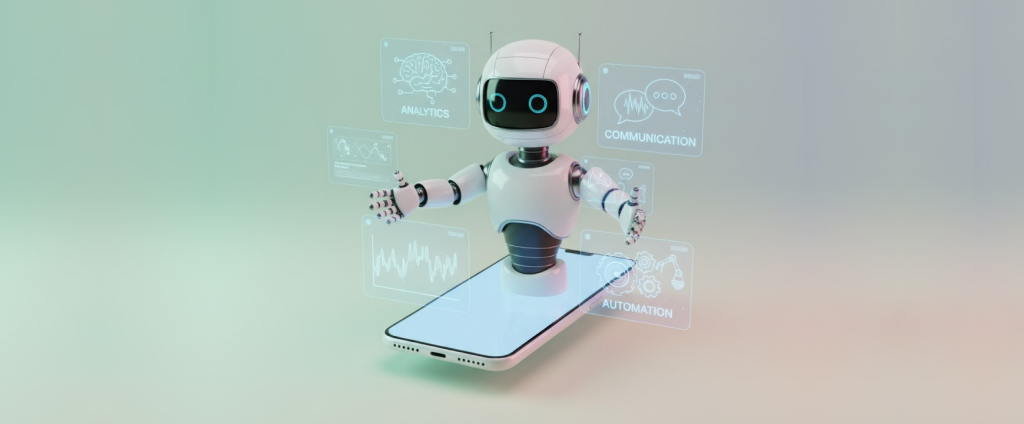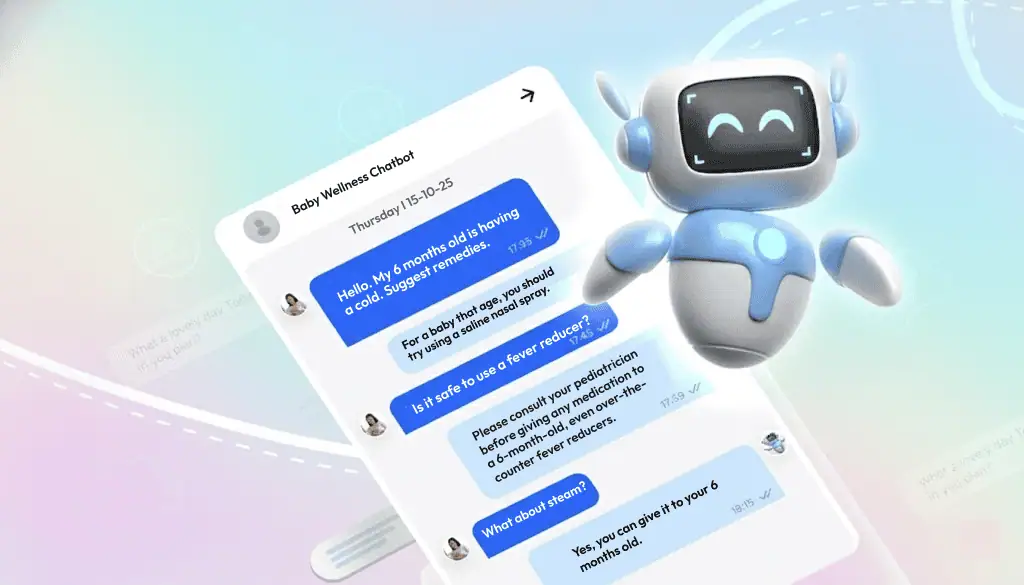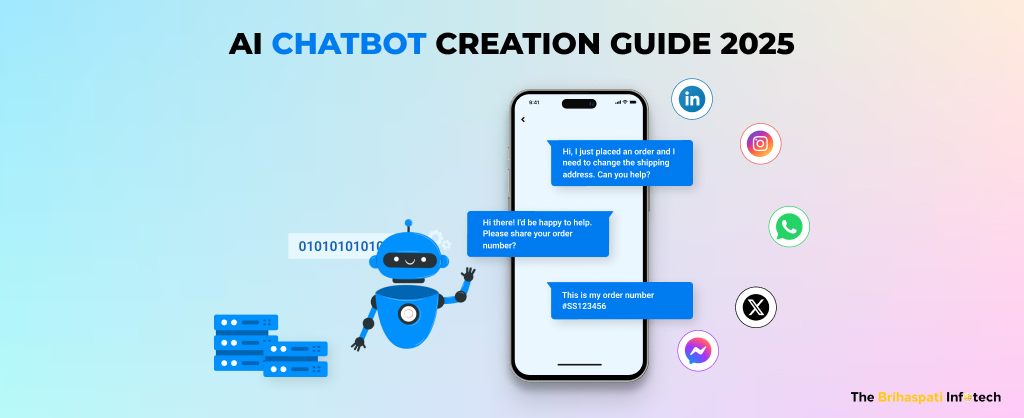
How to Create an AI Chatbot: AI Chatbot Development Guide, 2025
Planning to create an AI chatbot in 2025? You’re not alone. Over 1.4 million global companies use conversational AI chatbots to streamline customer service, sales, and internal workflows.
At The Brihaspati Infotech, we offer end-to-end AI chatbot development services — from conversation design and custom logic to platform deployment and social media integration.
Whether starting or scaling with automated customer support, hire AI developers to build performance-driven AI chatbots for your business. This guide walks you through the entire AI chatbot process — what to build, how to build it, and how to do it right the first time.
Why Create an AI Chatbot?
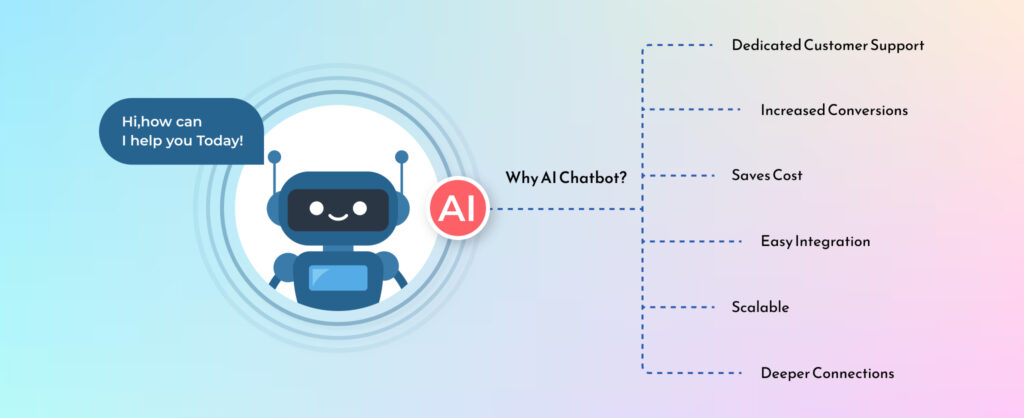
AI chatbots are instrumental in building an intelligent business. They are everywhere, answering customer queries, providing instant support, nurturing sales leads, and automating mundane tasks.
An AI chatbot is a sophisticated software app built to simulate human conversations via text or voice interactions. The underlying AI development technologies — Natural Language Processing (NLP) and Machine Learning (ML) — generate automated responses based on the user’s input, making them more flexible and adaptable.
Here are some compelling reasons why you should build an AI chatbot for your business:
- Dedicated Customer Support: AI chatbots provide instant support, 24/4. They not only resolve customer queries but also enhance user satisfaction, saving you ample time for addressing complex problems.
- Increased Conversions: AI chatbots help customers with everything, from product suggestions to pricing details. This helps push users down the sales funnel for conversion.
- Saves Cost: Implementing AI chatbots can save up to 30% or more. They automate nearly 80% of routine tasks, reducing the need for human agents.
- Easy Integration: Integrate AI chatbots with websites, mobile apps, messaging apps, and social media platforms, providing consistent performance across all touchpoints.
- Scalable: AI chatbots handles an increasing number of user interactions without compromising on performance.
- Deeper Connections: AI chatbots learn, unlearn, improve with every interaction, thus providing valuable information to build trust and brand loyalty.
Types of AI Chatbots to Create in 2025
The chatbot market is exploding, with the valuation pegged at $15.57 billion in 2025. So, while you’re exploring options, the first step is identifying the type of AI chatbot your business needs.
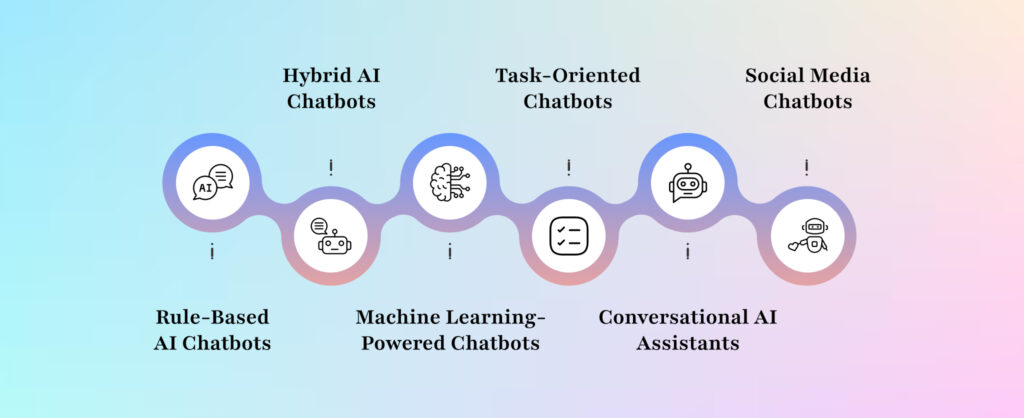
Here we are listing the 6 common types of AI chatbots for development:
- Rule-Based AI Chatbots
These AI chatbots operate based on predefined rules for queries involving keywords or phrases. They work well for simple tasks where interactions are clear and predictable.
- Machine Learning-Powered Chatbots
These AI chatbots learn from evolving user interactions. They can handle complex queries and adapt to different user behaviors, making them dependable for various tasks.
- Hybrid AI Chatbots
Hybrid chatbots combine rule-based systems and machine learning. They use rules for structured tasks and machine learning to adapt, offering a balanced solution for both predictable and dynamic scenarios.
- Task-Oriented Chatbots
These AI chatbots work for specific tasks such as answering questions, screening CVs, or scheduling appointments. They direct users to follow a well-defined process.
- Conversational AI Assistants
These AI chatbots are built for open-ended conversations. They can understand context, provide information, and execute commands, like Siri or Google Assistant.
- Social Media Chatbots
These AI chatbots operate within messaging platforms such as WhatsApp or Facebook Messenger. They provide instant, automated responses for customer service, marketing, and sales.
10 Essential Features to Create an AI Chatbot
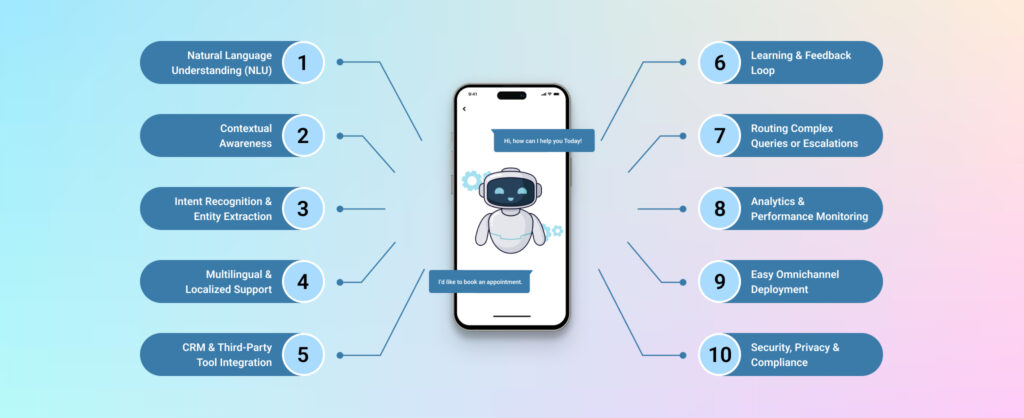
Most AI chatbot software has different types of features. Here are 9 fundamental features that you can consider for your AI chatbot development project.
1. Natural Language Understanding (NLU)
- Enables the chatbot to interpret human language accurately in real time.
- Recognizes typos, slang, and user intent using advanced language models.
- Supports sentiment detection to adapt tone and responses accordingly
2. Contextual Awareness
- Maintains conversation memory to deliver coherent, multi-turn dialogue.
- Adapts replies based on prior messages, user behavior, and session history.
- Essential for tasks like booking, product support, and personalized assistance.
3. Intent Recognition & Entity Extraction
- Understands user intent and collects relevant details from inputs.
- Effectively completes tasks and automates workflows with precision.
- Automated intent and entity processing reduces human dependency.
4. Multilingual & Localized Support
- Communicates naturally in multiple languages using NLP translation models.
- Accounts for cultural nuances, idioms, and tone for localized UX.
- Enables global scale without duplicating chatbot infrastructure.
5. CRM & Third-Party Tool Integration
- Connects with CRMs, ERPs, helpdesks, and marketing platforms via API.
- Pulls data like order history, preferences, or account info in real time.
- Enables personalized product suggestions, order tracking, and status updates.
6. Learning & Feedback Loop
- Improves accuracy over time with real-world interactions and admin feedback.
- Learns from failed or incomplete conversations to refine future responses.
- Supports manual or automated retraining workflows.
7. Routing Complex Queries or Escalations
- Processes intricate, multi-part questions using NLP and reasoning models.
- Extracts information from live data sources for relevant, up-to-date responses.
- Transfers complex queries to human agents with full context for efficient resolution.
8. Analytics & Performance Monitoring
- Provides insight into chatbot effectiveness, bounce rates, and engagement quality.
- Tracks KPIs like resolution time, NPS scores, drop-off points, and conversion influence.
- Informs iterative improvements based on real usage.
9. Easy Omnichannel Deployment
- Operates across websites, apps, messaging platforms (WhatsApp, Messenger), and voice assistants.
- Ensures seamless user experience with consistent branding and behavior.
- Allows customers to switch channels without losing context.
10. Security, Privacy & Compliance
- Implements data encryption, access control, and secure session management.
- Complies with global standards like GDPR, HIPAA, CCPA, and ISO.
- Builds user trust through privacy-first interactions and consent-driven design.
We can also create custom features for AI chatbots for your unique business needs.
How to Create an AI Chatbot in 7 Steps?

Creating an AI chatbot is more than plug-and-play business model — it’s a meticulous process involving 7 key steps to build a chatbot that delivers real business value.
Step 1: Define Your Goal
First and foremost, define what your AI chatbot is meant to achieve and how it fits into your business workflow.
Suggested Goals:
- Customer Support: Answer FAQs, order tracking, and resolve issues.
- Lead Generation: Qualify leads, collect contact details, and schedule demos.
- Product Discovery – Recommend products based on behavior and preferences.
- Education & Training – Assist learners, answer course-related questions.
Be specific, as clear goals lay down the foundation of successful AI chatbot development.
Step 2: Choose the Right AI Chatbot Development Platform
Select the right platform for your AI chatbot development project. There are different options available, each with distinct features and capabilities.
| Popular AI Chatbot Platforms & Frameworks | Best For |
| Microsoft Bot Framework | Enterprise-grade bots with Azure support |
| Dialogflow | Multilingual, natural conversations with Google Cloud Support |
| IBM watson Assistant | Voice chatbots for customer service and enterprise apps |
| Amazon Lex | Voice-enabled bots integrated with AWS services |
| Rasa | Open-source framework for custom bots with full control |
| Open AI (GPT-4/GPT-4o) | Advanced, free-form conversational bots using powerful AI models |
Consider language support, integration depth, and training capability before making the best choice for your business project.
Step 3: Design Conversational Flows
Conversation design involves generating natural language interactions between users and chatbots. Designing effective conversations isn’t just about choosing the right words but creating an experience that aligns with both user needs and business goals.
Use flowcharts or visual builders to map out:
- Possible user intents (e.g., ask for pricing)
- Follow-up questions and logical branches
- Fallback responses for unknown questions
Step 4: Develop & Train the AI Chatbot
Our AI chatbot development process includes:
- Backend logic, APIs, and database connectivity to manage interactions.
- Configure the chatbot engine with your chosen platform.
- Training the AI model on structured datasets: FAQs, chat transcripts, or synthetic data.
Use tools like spaCy, Hugging Face, or OpenAI APIs to enhance the bot’s language comprehension.
Step 5: Test AI Chatbot
Regular testing and iteration help create a user-friendly and reliable AI chatbot. We use multi-faceted approach to ensure the chatbot functions as expected.
- Functional tests: Does the chatbot respond correctly?
- Usability tests: Is the experience smooth for users?
- Stress tests: How does it handle unexpected queries?
Additionally, try real-world queries and scenarios like:
- Misinterpreted intents
- Broken loops or dead ends
- Inconsistent tone or logic
AI testing helps avoid post-launch problems and ensures your bot’s value holds up in real-time.
Step 6: Deploy AI Chatbot
After your chatbot is trained and tested, it’s time to go live. There are different AI chatbot deployment channels used by companies:
- Your website: Configure chat widget to match the design.
- Messaging platforms like WhatsApp, Facebook Messenger, or Instagram
- Mobile apps or even voice assistants like Alexa.
Go live — but keep watching to improve your chatbot.
Step 7: Monitor, Analyze & Improve
A good chatbot isn’t just deployed — it’s continuously optimized to stay relevant and effective. Post-launch, your AI chatbot should evolve based on how users interact with it.
Use analytics tools to monitor and optimize:
- Engagement rate
- Abandonment or bounce points
- Completion of key actions (like lead form submission or issue resolution)
Based on this insightful data and information, you can retrain the AI model, adjust conversation flows, or integrate new features for optimal results.
Key Implementation Challenges to Create an AI Chatbot
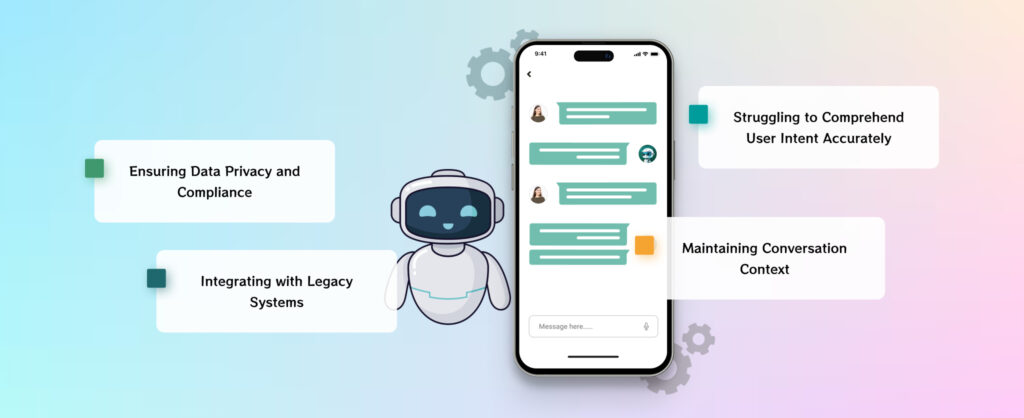
AI chatbots are no longer just virtual agents; they have become an indispensable part of your business. However, building a high-performing AI chatbot isn’t easy. Here are four critical challenges most businesses face and how to solve them.
1. Struggling to Comprehend User Intent Accurately
Poor intent recognition leads to irrelevant chat responses with 62% of users abandoning carts in frustration.
Even with advanced NLP, chatbots still misinterpret real-world queries — especially when users use slangs, typos, or mixed languages.
Proposed Solutions:
- Train your chatbot on domain-specific data — not just open or broad datasets.
- Use advanced NLP models (like Claude) that support few-shot learning for better generalization.
- Retrain AI with actual user queries, including edge cases and failure examples.
2. Maintaining Conversation Context
Most users expect natural, back-and-forth dialogue with chatbots. However, many AI chatbots fall short on contextual memory.
Over 90% of users have had to repeat themselves to a chatbot due to poor memory of previous inputs.²
That’s a major break in chatbot UX and leads to high abandonment rates.
Proposed Solutions:
- Use platforms that support multi-turn context handling (e.g., Rasa and Dialogflow CX).
- Store short-term conversation history using session memory or tokens.
- Test across use cases like follow-ups, rephrased questions, or ambiguous responses.
3. Ensuring Data Privacy and Compliance
AI chatbots often handle sensitive customer data, making compliance with GDPR, HIPAA, and other regulations non-negotiable. However, as AI adoption scales, privacy concerns are heard loudly, especially in finance, healthcare, and eCommerce.
Proposed Solutions:
- Choose trusted platforms with built-in compliance frameworks (GDPR, HIPAA, CCPA).
- Apply end-to-end encryptions for all stored and transmitted data.
- Regularly audit data access, logging, and retention policies.
4. Integrating with Legacy Systems
Integration remains a top technical barrier for enterprises adopting AI-driven chat, especially in regulated or data-heavy industries. Without reliable system sync, even the smartest bots operate in silos.
Connecting chatbots with older CRMs, ERPs, or custom tech stacks isn’t always smooth. Legacy systems lack the APIs or flexibility modern chatbots need.
Proposed Solutions:
- Use middleware or API gateways to normalize legacy system communication.
- Leverage custom connectors and webhook logic for sync with older CRMs or ERPs.
- Consider a hybrid architecture where AI bots fetch only necessary data on request to reduce system load.
Create An AI Chatbot with these Key Technologies
Choosing the right tech stack is integral for successful AI chatbot development. Here are some popular tools and technologies used to build AI chatbots for businesses.

You can choose it from here or we can help you select the best tech stack for your AI chatbot project.
5 Industries that Benefit from AI Chatbot Development
AI chatbots are everywhere. Here are 5 key industries that benefit the most from AI chatbot development with real impact on efficiency, customer experience, and scalability:
Healthcare
People have grown habitual of conversing with chatbots, and patients are no different. In fact, 52% of patients in the US use chatbots to access medical reports and other healthcare data. They assist with appointment scheduling, symptom assessment, and medication reminders. Additionally, they enable patients to enquire about health-related concerns and reduce admin burden.
eCommerce & Retail
Nearly 60% of shoppers use chatbots before purchasing. Retailers implement AI for eCommerce to guide customers through product discovery, handle returns, answer FAQs, and recover abandoned carts. These bots drive sales by offering personalized recommendations and improving customer satisfaction with 24/7 assistance.
Banking & Finance
In banking, 70% of customers have used the same chatbot repeatedly. AI chatbots handle routine queries like account balances, transaction history, or card status. They streamline customer service, reduce call center volume, and provide real-time financial advice securely.
HR & Training
Many HR departments credit AI chatbots to save more than 12,000 work hours annually. How? From automating repetitive tasks like recruitment and onboarding to managing leaves and providing insights via surveys and interactions. HR chatbots assists companies improve employee experience.
Education & eLearning
Educational platforms launch AI chatbots to answer course-related questions, assist with enrollment, and deliver learning content online. These bots provide interactive, on-demand academic support that enhances student experience.
Frequently Asked Questions
AI chatbots are software programs that simulate human-like conversations. They understand user inputs using NLP and respond to users across websites, mobile apps, messaging platforms, and more.
Businesses create AI chatbots to automate customer service, generate leads, answer FAQs, or even handle transactions — 24/7, without human agents.
There are many platforms, but some of the best AI chatbot builders in 2025 include:
1. OpenAI ChatGPT (GPT-4o): Best for advanced, customizable bots.
2. Google Dialogflow CX: Great for complex, multilingual conversations.
3. Microsoft Bot Framework: Ideal for enterprise-grade chatbots.
4. IBM Watson Assistant: Focuses on compliance-heavy industries.
5. Rasa: A powerful open-source framework for full control.
Each platform helps you create an AI chatbot tailored to unique business needs.
Yes, you can create an AI chatbot for free using platforms like Dialogflow (basic tier), Tidio, or ChatGPT (free version). They offer basic features to build AI chatbots. However, for advanced features or capabilities like integrations or AI training, paid plans are often required.
No, coding is not always required to build an AI chatbot. Platforms like Landbot, ManyChat, and Tidio offer drag-and-drop interfaces for building bots without programming. But if you want a fully custom chatbot, you need to have basic knowledge of JavaScript, Python, or APIs.
Or you can partner with our AI development company for custom AI chatbot solutions.
Reach out today
Here are some key steps to create an AI chatbot:
1. Define the goal (e.g., customer support, lead capture).
2. Choose a chatbot platform like ChatGPT, Dialogflow, or Rasa.
3. Design the conversation flow and user interactions.
4. Train the bot using NLP and real user queries.
5. Test and deploy it across your website or messaging apps.
For a scalable conversational AI solution, you may also hire AI developers like us to handle chatbot design, integration, and maintenance.
The cost to build an AI chatbot using no-code tools starts from $500/month. However, custom AI chatbot development can cost up to $2,000 or more, depending on project scope and complexities.
Request a custom quote today
Ready to Create an AI Chatbot?
AI chatbots are no longer optional — they’re essential. From lead generation to customer support, the right chatbot can transform how your business operates.
At The Brihaspati Infotech, we don’t just build bots — we create smart, secure, and scalable AI chatbot solutions tailored to your business goals.
Want a chatbot that engages, converts, and grows with your business? Or looking for a custom conversational AI solution? Our AI development company can help you build custom chatbot solutions.
Reach out today and bring your AI chatbot vision to life.
Stay Tuned for Latest Updates
Fill out the form to subscribe to our newsletter



